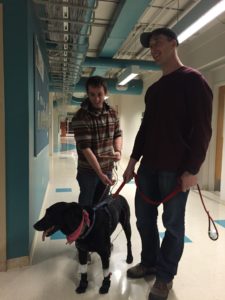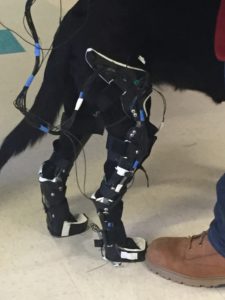Exoskeletons are usually associated with animals like grasshoppers, crabs, or tortoises – not dogs. But a canine exoskeleton being created by CSU engineers represents a new direction for the rehabilitation of injured dogs.

Anura Jayasumana, a professor in CSU’s Department of Electrical and Computer Engineering, and an associate faculty in the School of Biomedical Engineering, leads a group of undergraduates in this long-term project that supplements movement for semi-paralyzed dogs. Instead of a prosthesis to substitute a missing limb, the canine exoskeleton supplements movement for dogs with weak or non-functioning limbs. Until recently, the technology needed to process information fast enough to capture and imitate movement did not exist, so the project may be the first of its kind.
Sensing and simulating movement
To create a functioning exoskeleton, data on canine movement first has to be captured. Data collection braces are worn by a healthy dog, and the braces record movement as the dog walks, runs, sits, goes up stairs, and even rolls around in the snow.
Once the data is captured, an intelligent controller applies the appropriate inputs into motorized braces that are worn by a semi-paralyzed dog. The sensors built into the braces are used to anticipate intent, and cause movement of the programmed brace to simulate the muscle and leg movement of the dog’s hind legs. This also functions as physical therapy for the dog.

With the help of OrthoPets and the CSU Veterinary Teaching Hospital, Jayasumana’s group have achieved proof of concept with a “walking” motorized exoskeleton controlled by data from a live dog. The next step will be to gather financial support to attain new parts, like smaller motors to create a less awkward, lightweight and real-time responsive brace.
Caring for canine companions
Spinal issues are the primary reason for a dog to require this type of rehabilitation, which specific breeds are more susceptible to than others, and can be caused by aging or injuries. In a society that values canine companions, the exoskeleton is a step toward extending the lives of dogs. The rehabilitation method could relieve owners struggling to care for semi-paralyzed pets – especially larger dogs that need to be carried, and improve quality of life for those pets as well.
Dr. Rebecca Packer, associate professor of neurology and neurosurgery at the Veterinary Teaching Hospital, is one of the clinicians that advised the team on the project. She has treated many dogs that could benefit from the technology, and calls this research a “first step,” literally and figuratively.
“There’s nothing like this in dogs, so they are definitely taking the first step. There are carts which function like wheelchairs, but the carts aren’t something they can wear indefinitely because they cannot relax and lie down in a cart. Dogs that don’t have independent function would be able to have independent movement with this exoskeleton,” Packer said. “I think it has lots of applications. Their vision is to try to help support people as well, but using animal studies as a model. What they are creating is relevant – and really cool.”
The owner of two dogs, (Gori, a Red Heeler, and Myers, a Jack Russell Terrier), Jayasumana understands the need for the technology. As the research project enters its second year, he looks forward to helping create a safe and simple form of physical therapy for fellow dog owners.